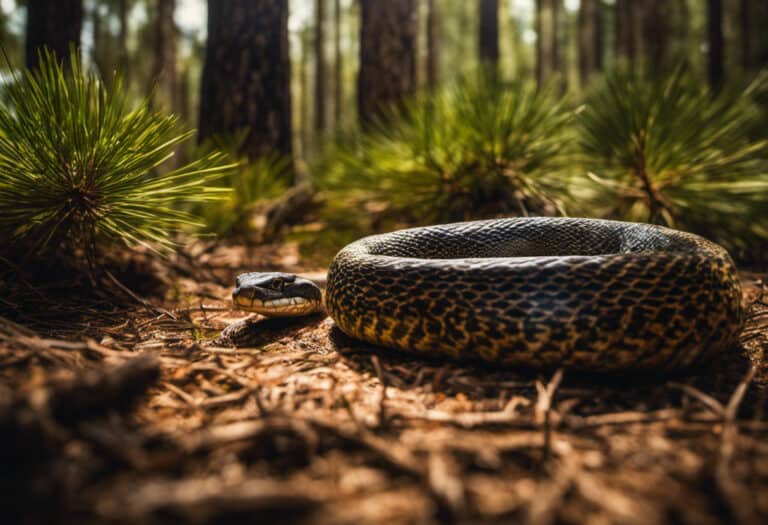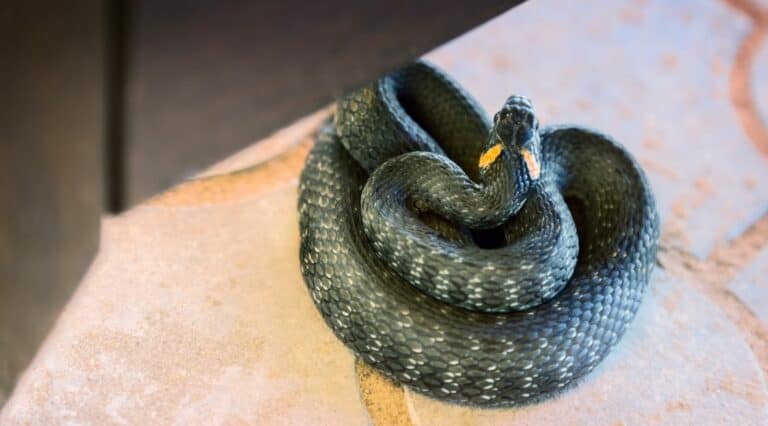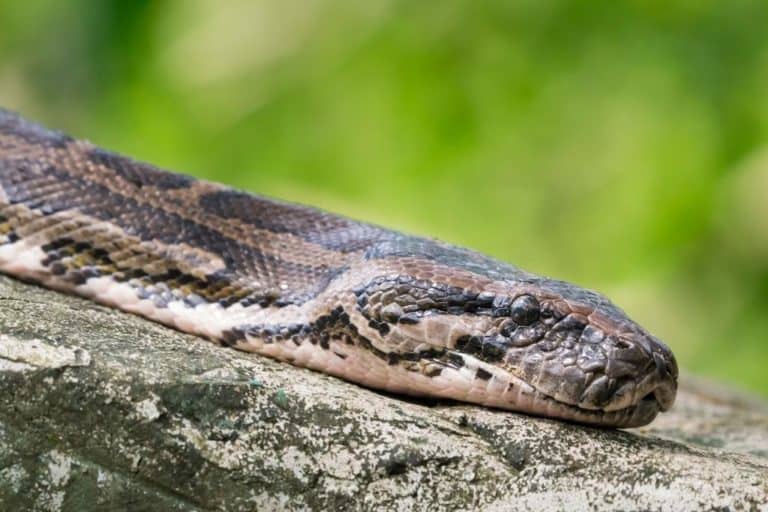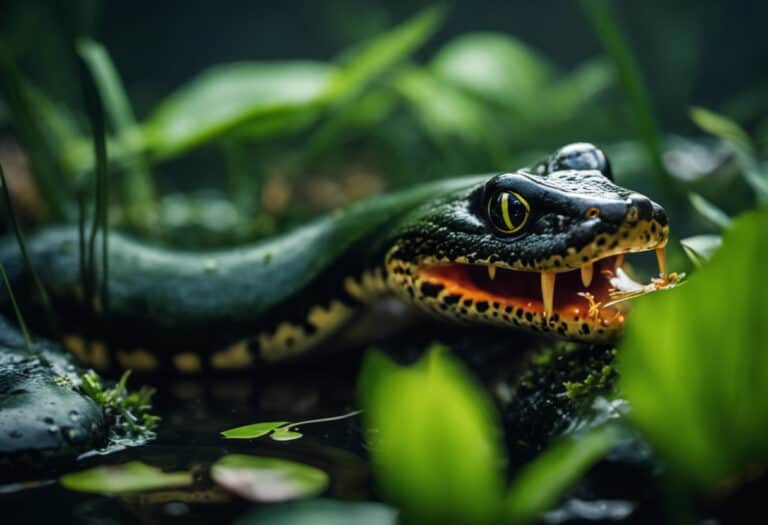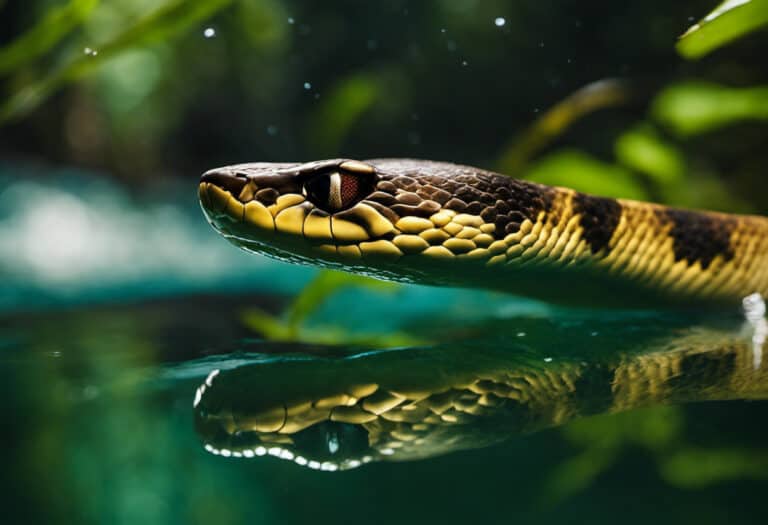Do Black Snakes Travel in Pairs?
Have you ever wondered if black snakes travel in pairs?
The behavior of black snakes has fascinated both nature lovers and researchers. To understand their habits, we must delve into the world of snakes in general.
Most snakes are solitary creatures, preferring to live and hunt alone. While there are exceptions, like garter snakes huddling for warmth during hibernation, black snakes typically remain solitary.
In this article, we will explore the reasons behind their solitary nature and the limited instances of group behavior in snake-like species.
Key Takeaways
- Black snakes, like most snake species, are solitary creatures and prefer to live and hunt alone.
- Solitary behavior allows black snakes to conserve energy, reduce competition, and increase their chances of finding prey.
- Black snakes do not exhibit complex social behaviors or travel in pairs or groups.
- While some snake-like species may exhibit group behavior, the majority of snakes, including black snakes, remain solitary in their behavior.
The Solitary Nature of Black Snakes
Black snakes, like most snake species, prefer to live and hunt alone, exhibiting a solitary nature. While some snake-like species may exhibit group behavior, the majority of snakes, including black snakes, remain solitary. This solitary behavior offers several advantages.
Firstly, it allows black snakes to avoid competition for resources, increasing their chances of finding prey and reducing the risk of starvation.
Additionally, living alone reduces the likelihood of conflicts and fights among snakes. Factors influencing group formation in snakes are limited as they primarily communicate through chemical signals called pheromones.
Unlike mammals or birds, snakes don’t exhibit complex social behaviors or long-term social bonds. Black snakes, therefore, thrive in their solitary existence, free from the constraints of group living.
Snake Behavior: Solo Travelers
If you encounter a snake in the wild, it’s likely to be traveling alone rather than in pairs or groups. Snakes are solitary creatures, preferring to live and hunt alone. This behavior allows them to conserve energy and reduce competition. They may exhibit territorial behavior to defend their hunting grounds.
Here are some key points about snake behavior:
- Snakes are solo hunters, relying on their own skills to find prey.
- They mark their territories with pheromones to communicate and defend their hunting grounds.
- Solo hunting allows snakes to avoid competition for resources and reduce the risk of starvation.
- Solitary behavior also reduces the likelihood of conflicts and fights among snakes.
Overall, snakes are independent creatures that thrive in their solitary lifestyle, using territorial defense to ensure their survival.
Exceptions to Solitary Behavior in Black Snakes
When encountering a snake in the wild, you may be surprised to learn that some species, such as the Cuban boa, exhibit exceptions to their typically solitary behavior.
While snakes are generally solitary creatures, the Cuban boa, a member of the boa family, may form groups consisting of a female and her offspring. These groups provide protection for the young snakes and are a rare example of communal behavior in snakes.
Additionally, some snake species, like the king cobra, engage in mating rituals involving multiple individuals. However, these interactions are brief and don’t indicate long-term group behavior.
Snakes, in general, prefer to live and hunt alone, as solitary behavior allows them to conserve energy and reduce competition. So, while exceptions like communal dens and mating rituals exist, the majority of snakes remain solitary in their behavior.
Benefits of Solitary Behavior in Black Snakes
You may be interested to know that solitary behavior in snakes allows them to avoid competition for resources and increases their chances of finding prey. However, there are certain advantages of group living in other species, but snakes tend to thrive in solitude. Factors influencing group formation in snakes are limited, as most snake species prefer to live and hunt alone.
Here are some reasons why solitary behavior benefits black snakes:
- Avoiding competition: Solitary behavior allows black snakes to have access to resources without having to compete with others for food, shelter, and mates.
- Increased hunting success: Being alone increases their chances of finding prey, as they don’t have to share hunting grounds or compete for food.
- Reduced risk of predation: Solitary snakes can better hide from predators by not attracting attention in groups, increasing their chances of survival.
- Lower transmission of diseases: By not living in groups, black snakes have a lower risk of transmitting diseases to others.
Communication and Social Interactions of Black Snakes
The communication and social interactions of black snakes primarily rely on chemical signals called pheromones to attract mates and mark their territories.
Black snakes, like other snake species, use pheromones as a means of courtship behavior, signaling their availability and readiness to breed.
Male black snakes release pheromones into the environment to attract females and engage in courtship rituals. These rituals may involve intricate movements and displays to impress potential mates.
Additionally, black snakes use pheromones to mark their territories, leaving behind scent trails that communicate ownership and deter other snakes from entering their space. This territorial marking behavior helps reduce competition for resources and ensures successful reproduction.
While black snakes may exhibit brief social interactions during courtship and territorial marking, they generally remain solitary creatures, preferring to live and hunt alone.
Group Behavior in Snake-Like Species: A Closer Look
If you come across a Cuban boa or a blind snake, you may observe group behavior, unlike the majority of snakes that remain solitary. While most snakes prefer to live and hunt alone, there are exceptions to this behavior. Here is a closer look at the group behavior exhibited by snake-like species:
-
Group living advantages: Group living can provide benefits such as increased protection for offspring, shared resources, and enhanced defense against predators.
-
Factors influencing group formation: Group formation in snake-like species can be influenced by factors such as the need for protection, mating opportunities, and nesting requirements.
It is important to note that these instances of group behavior are exceptions to the solitary nature of snakes. The majority of snake species still prefer to live and hunt alone, utilizing the advantages of solitary behavior to conserve energy and reduce competition.
The Cuban Boa: An Exception to Solitary Behavior
The Cuban Boa, unlike most snake species, exhibits an exception to solitary behavior. They’re known to form small groups consisting of a female and her offspring, providing protection and support for the young snakes.
This communal behavior in the Cuban Boa challenges the general understanding of snakes as solitary creatures and sheds light on the complexity of social interactions within certain snake-like species.
Communal Behavior in Boas
Boas, unlike most snakes, may exhibit communal behavior by forming groups consisting of a female and her offspring. This unique behavior sets them apart from other solitary snake species.
Here are some interesting facts about communal behavior in boas:
-
Communal dens: Boas have been observed sharing communal dens, where multiple snakes cohabitate. These dens provide safety and protection from predators.
-
Group dynamics: Within these groups, the female boa takes on the role of the leader, guiding and protecting her offspring. This dynamic allows for cooperative hunting and defense against threats.
-
Communication: Boas use chemical signals, such as pheromones, to communicate with each other within their group. This helps them coordinate activities and maintain social cohesion.
-
Benefits of communal behavior: Living in groups provides boas with increased security, better access to resources, and opportunities for learning from each other’s experiences.
While most snakes prefer solitary lifestyles, boas demonstrate the remarkable ability to form and thrive in communal groups. This behavior showcases their adaptability and highlights the diverse strategies that animals employ for survival.
Advantages of Group Living
Living in groups provides you with increased security, better access to resources, and opportunities for learning from each other’s experiences. This is true for many species, including humans, but what about snakes?
While snakes are generally solitary creatures, there are some advantages to social living and cooperative hunting strategies in certain snake-like species. For example, the Cuban boa, a member of the boa family, forms groups consisting of a female and her offspring. This group living provides protection for the young snakes, increasing their chances of survival.
Additionally, some species of blind snakes may form small groups for mating and nesting purposes. By working together, these snakes can share the workload of hunting and nesting, leading to improved efficiency and success.
While social living isn’t common among snakes, these exceptions demonstrate the benefits of cooperative behaviors in certain situations.
Factors Influencing Group Formation
When considering snake behavior, it’s important to understand the factors that influence the formation of groups. Snakes are generally solitary creatures, preferring to live and hunt alone. However, there are exceptions to this behavior.
Factors influencing group dynamics in snakes include the need for warmth and protection, as seen in species like garter snakes that form communal dens during hibernation. Another factor is mating rituals, where certain snake species engage in brief interactions involving multiple individuals, such as the king cobra.
While the majority of snakes remain solitary, there are social benefits of group formation for some snake-like species, like the Cuban boa and blind snakes, which provide protection and nesting opportunities.
Overall, the formation of snake groups is influenced by specific environmental and reproductive requirements.
Group Behavior in Blind Snakes: Insights and Observations
Blind snakes, unlike the majority of snakes, may form small groups for mating and nesting purposes. While most snakes are solitary creatures, blind snakes exhibit a unique behavior that defies this norm.
Research has shown that blind snakes, such as the species Ramphotyphlops braminus, engage in communal nesting and mating rituals.
These small groups consist of a male and several females, who come together for the purpose of reproduction and creating nests. The communal nesting behavior allows the blind snakes to share resources and provide protection for their offspring.
Mating rituals in blind snakes involve complex courtship displays and chemical signaling through pheromones. These behaviors highlight the fascinating social dynamics of blind snakes and provide a rare glimpse into the world of group behavior in snake species.
Conclusion: Black Snakes and Their Travel Habits
In conclusion, black snakes, like most snake species, exhibit solitary behavior and prefer to live and hunt alone. They don’t typically travel in pairs or groups, as their solitary nature allows them to conserve energy and reduce competition.
While there may be exceptions in certain snake-like species, the majority of black snakes remain solitary in their travel habits.
Pairing in Black Snakes
Black snakes, like other snake species, prefer to live and hunt alone, and they don’t typically travel in pairs or groups. However, there are some factors that can influence group formation in black snakes. Understanding the advantages of pairing in black snakes can shed light on this behavior.
Advantages of pairing in black snakes:
- Increased protection: Pairing can provide protection against predators, as snakes can watch each other’s backs.
- Enhanced hunting efficiency: Two snakes working together can increase their chances of catching prey.
- Successful mating: Pairing allows for successful reproduction and ensures the survival of the species.
- Social interaction: While not as complex as mammals or birds, pairing in black snakes allows for limited social interaction.
Factors influencing group formation in black snakes:
- Environmental conditions: When resources are scarce, black snakes may tolerate the presence of others to increase their chances of survival.
- Reproductive needs: During mating season, black snakes may form temporary pairs to facilitate successful reproduction.
- Habitat suitability: In certain habitats, such as dense vegetation or rocky crevices, black snakes may find it advantageous to form pairs for shelter and protection.
While black snakes typically prefer solitary behavior, these factors can sometimes lead to the formation of pairs or temporary groups.
Travel Habits of Black Snakes?
You may be wondering about the typical movement patterns of solitary black snakes.
Black snakes, like many other snake species, are primarily solitary creatures. They prefer to live and hunt alone, avoiding group dynamics. This behavior allows them to conserve energy and reduce competition for resources.
While some snake species may exhibit exceptions to solitary behavior, such as forming communal dens or engaging in brief mating rituals, black snakes don’t typically exhibit these behaviors. They tend to migrate individually, without forming groups or traveling in pairs.
Their migration patterns are influenced by factors like seasonal changes, food availability, and habitat suitability. So if you come across a black snake, rest assured that it’s most likely traveling on its own, enjoying the freedom of its solitary existence.
Frequently Asked Questions
Are There Any Snake Species That Naturally Travel in Pairs or Groups?
No, snakes are generally solitary creatures. They prefer to live and hunt alone. While some snake species may briefly interact for mating or nesting, the majority of snakes, including black snakes, do not naturally travel in pairs or groups.
Do Black Snakes Form Communal Dens During Hibernation Like Some Other Snake Species?
No, black snakes do not form communal dens during hibernation like some other snake species. They usually prefer to hibernate alone, as solitary behavior is common among snakes.
Are There Any Social Interactions or Complex Social Behaviors Observed in Black Snakes?
Black snakes, like other snake species, are typically solitary creatures. They do not exhibit complex social interactions or form long-term groups. However, they may exhibit territorial behavior to defend their hunting grounds.
Can Black Snakes Communicate With Each Other Using Pheromones or Other Chemical Signals?
Black snakes, like other snakes, use pheromones and chemical signals to communicate. These signals play a crucial role in their behavior, such as attracting mates and marking territories.
Do Snake-Like Species, Such as the Cuban Boa, Exhibit Group Behavior Similar to Black Snakes?
Yes, snake-like species such as the Cuban boa exhibit some group behavior, providing protection for offspring. However, this is not the norm for most snakes, including black snakes, which prefer solitary hunting and reproductive techniques.
Conclusion
As you delve into the fascinating world of black snakes, you discover their preference for solitary travel and the benefits it provides.
Their communication and social interactions remain minimal, emphasizing their self-reliance and independence.
While exceptions like the Cuban Boa and blind snakes exhibit some group behavior, black snakes predominantly remain solo travelers.
Symbolizing resilience and adaptability, black snakes remind us of the beauty in solitude and the importance of conserving energy in our own journeys.
